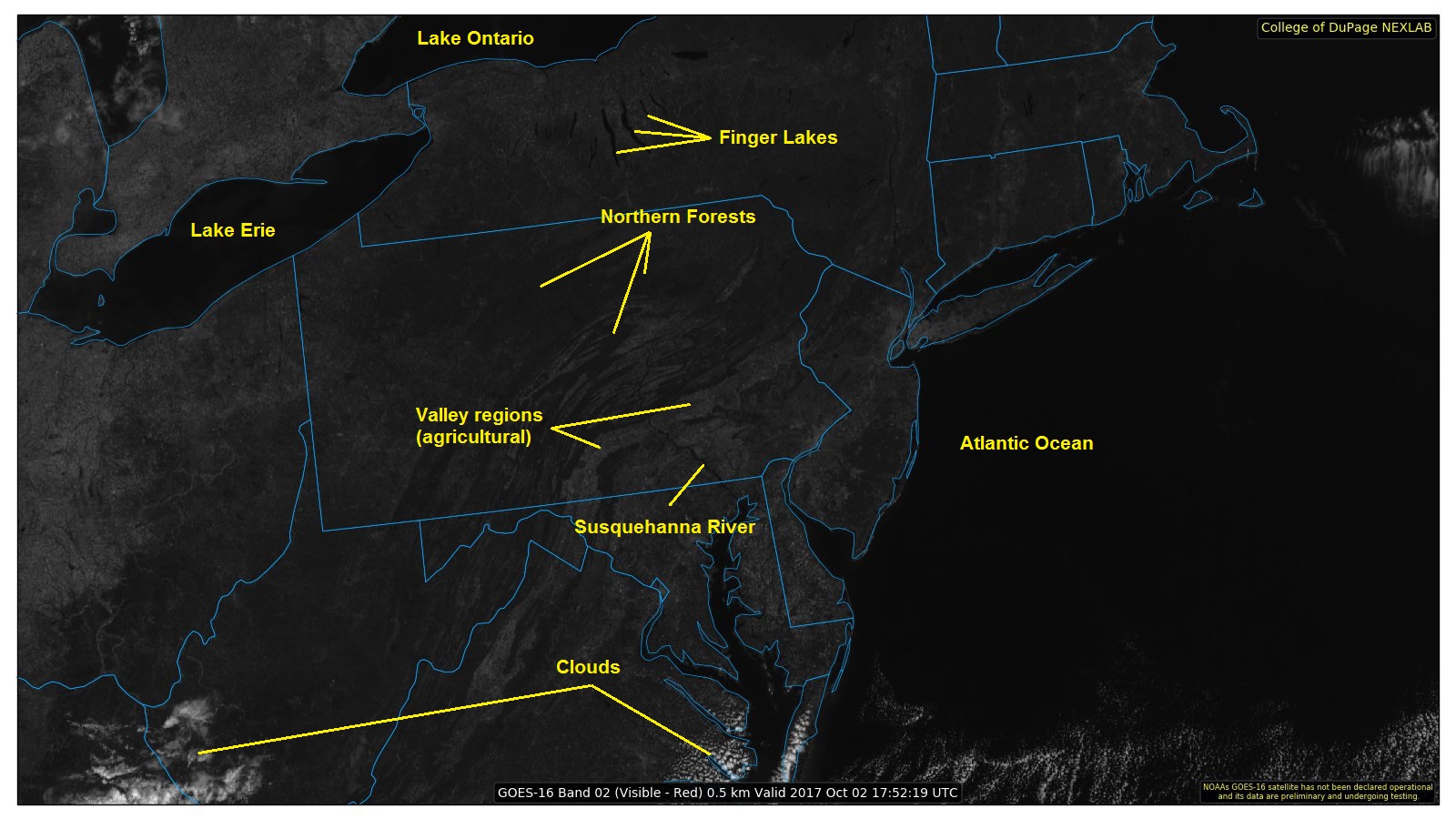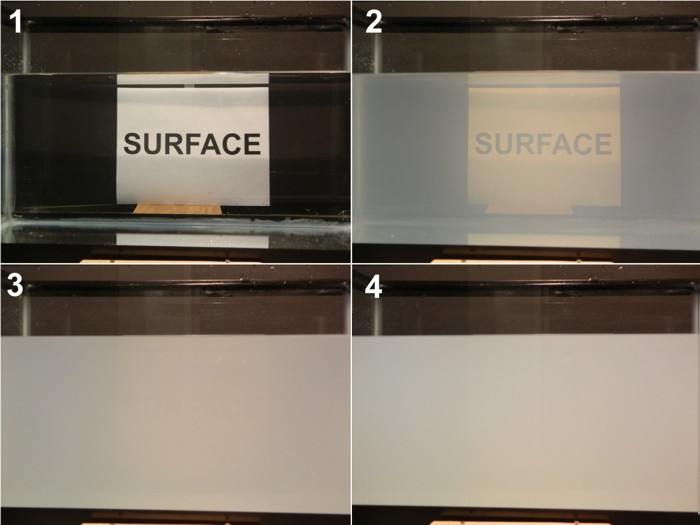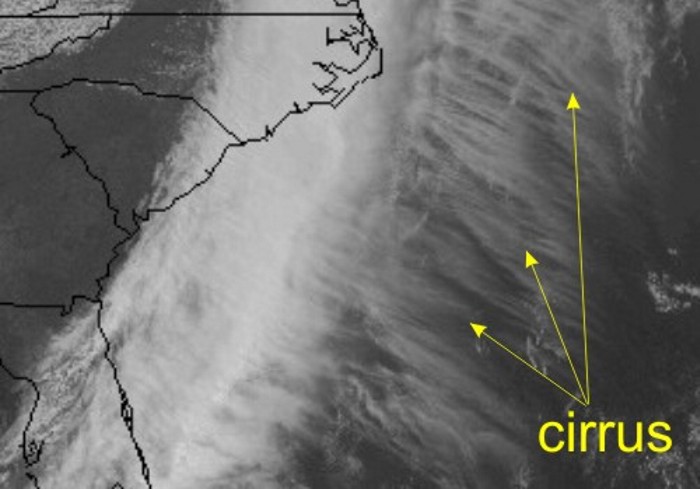Prioritize...
At the completion of this section, you should be able to describe how a satellite constructs an image in the visible spectrum (describe what's being measured) and how to interpret visible satellite images. Specifically, you should also be able to describe when it is appropriate to use visible satellite imagery and when it is not, and discern the relative thickness of various cloud types. After completing the sections on infrared imagery, water vapor imagery, and radar imagery, you should also be able distinguish visible satellite imagery from these other types of images.
Read...
Perhaps you've heard a television weathercaster use the phrase "visible satellite image" before. Perhaps you also thought, "Of course it's visible if I can see it!" So, why make the distinction that a satellite image is "visible?" In short, visible satellite images make use of the visible portion of the electromagnetic spectrum. If you recall the absorptivity graphic that I introduced earlier, notice that from a little less than 0.4 microns to about 0.7 microns, there's very little absorption of radiation at these wavelengths by the atmosphere. In other words, the atmosphere transmits most of the sun's visible light all the way to the Earth's surface.
Along the way, of course, clouds can reflect (scatter) some of the visible light back toward space. Moreover, in cloudless regions, where transmitted sunlight reaches the Earth's surface, land, oceans, deserts, glaciers, etc. unequally reflect some of that visible light back toward space (with limited absorption along the way). You might say that visible light generally gets a free pass while it travels through the atmosphere.
An instrument on the satellite, called an imaging radiometer, measures the intensity (brightness) of the visible light scattered back to the satellite. I should note that, unlike our eyes, or even a standard camera, this radiometer is tuned to measure only very small wavelength intervals (called "bands"), so the instrument does not see all wavelengths of visible light. The shading of clouds, the Earth's surface (in cloudless areas) and other features, such as smoke from a large forest fire, the plume of an erupting volcano, or even chunks of ice floating on a lake can all be seen on a visible satellite image because of the sunlight they reflect.
What determines the brightness of the visible light reflected back to the satellite and thus the shading of objects on a visible satellite image? Well to start with, we need to have a some source of light. To see what I mean, check out this visible satellite loop of the United States spanning from roughly 10Z to 17Z on May 1, 2024. The United States is completely dark at the beginning because 10Z was still before sunrise, but gradually we start to see clouds appear on the image from east to west as the sun rose and the reflected sunlight reached the satellite. The bottom line is that standard visible satellite imagery is only useful during the local daytime because we are measuring the amount of sunlight being reflected from clouds and the surface. If there's no sunlight, there's no image.
Now, assuming that it's during the day, the brightness of the visible light reflected by an object back to the satellite largely depends on the object's albedo, which is simply the percentage of light striking an object which gets reflected. Since the nature of Earth's surface varies from place to place (paved streets, forests, farm fields, water, etc.), the surface's albedo varies from place to place.

For example, take a look at the visible satellite image showing Pennsylvania and surrounding states (above). For the full effect, I recommend opening the full-sized version of the image for a better look. This particular day was nearly cloudless over Pennsylvania, so it gives us a great opportunity to really see how albedo makes a difference in the appearance of an object on visible satellite imagery. The surface in Pennsylvania hardly looks uniform, and that's a result of differing albedos associated with different surfaces. For example, bare soil reflects back about 35 percent of the visible light that strikes it. Vegetation has an albedo around 15 percent. By the way, bodies of water, with a representative albedo of only 8 percent, typically appear darkest on visible satellite images. See how the labeled bodies of water all look darker than the land surfaces?
If you want another comparison point, check out the "true color" satellite view of Pennsylvania and surrounding states from Google. Can you see how the heavily forested areas of northern Pennsylvania match up with the darker shaded areas I've highlighted above? Can you see how the largely agricultural valleys of southeastern Pennsylvania (with their higher albedo) appear a bit brighter on the image above? Of course, the brightest areas on the visible satellite image above correspond to clouds, which have a much higher albedo than the surface of the earth under most circumstances.
But, many different types of clouds exist, and they all have varying albedos, too! To see what I mean, let's perform an experiment. First, start with a tank of water (upper left in the photograph below). Now add a just tablespoon of milk (upper right), which increases the albedo a bit. By adding the milk, some of the radiation that is passing front-to-back through the tank is being scattered back towards the observer and the water-milk mixture takes on a whitish appearance. In frames #3 and #4 (lower-left and lower-right, respectively), we've added more milk. Now we see that the tiny globules of milk fat further increase albedo as more of the visible light is being scattered back toward the observer, while the transmission of light through the water-milk mixture decreases (that's why the word "SURFACE" is obscured).

Some key observations that you should note from this experiment:
- It didn't take many globules of milk fat (1 tablespoon of milk in a 10-gallon fish tank) to begin noticeably decreasing transmission and increasing albedo.
- A medium can very quickly become "optically thick" -- that is, nearly zero transmission and a high albedo (a large percentage of light is reflected back to the observer)
- In frame #4, we had only added a total of three tablespoons of milk to the tank (so the tank is still mostly filled with water, yet the transmission of light through the tank is minimal and the albedo is fairly high. Even if we switched to a tank filled with pure milk, the albedo would only increase marginally (maybe another 20 or 30 percent).
This last point is true of clouds as well; once a cloud becomes "thick enough," additional growth will not change its albedo (and appearance on visible satellite imagery) appreciably. The bottom line is that thick clouds, like cumulonimbus (which are associated with showers and thunderstorms), are like tall glasses of milk in the sky; they contain lots of light-scattering water droplets and/or ice crystals. Meteorologists say that such clouds have a "high-water (or ice) content" and can have albedos as high as 90 percent, which causes them to appear bright white on visible satellite imagery.
More subdued clouds, such as fog and stratus, typically have a lower water content, and, in the spirit of the glass of water with just a little milk, a lower albedo. Indeed, the albedo for thin (shallow) fog and stratus can be as low as 40 percent. So, as a general rule, fog and stratus often appear as a duller white appearance compared to thicker, brighter cumulus clouds. Here's an example of valley fog over Pennsylvania and New York for reference. Wispy, thin cirrus clouds have the lowest albedo (low ice content), averaging about 30 percent. They appear almost grayish compared to the bright white of thick cumulonimbus clouds outlined on the satellite image below.

As a general caveat to our discussion about determining shading on visible satellite images, I point out that brightness also depends on sun angle. For example, the brightness of the visible light reflected back to the satellite near sunset is limited, given the low sun angle and the relatively high position of the satellite. To see what I mean, check out this loop of visible satellite images showing severe thunderstorms, which erupted over Oklahoma and Kansas. The tall, thick cumulonimbus clouds that developed appear bright white initially, but as sunset approaches, the appearance of the clouds darkens. If you look closely at the images later in the loop, you'll be able to see tall cumulonimbus clouds casting shadows to the east. Pretty cool, eh?
One more quick point about interpreting visible images. Clouds aren't the only objects that can have very high albedos; therefore, they're not the only objects that can appear whitish. Indeed, cloudless, snow-covered regions can have albedos as high as 80 percent, and they also appear bright white on visible imagery. To see how to tell the difference between clouds and snow cover on standard visible imagery, check out the Case Study below, after reviewing the following summary highlighting the important characteristics of visible satellite imagery:
Visible satellite imagery...
- is based on the albedo of objects (the fraction of incoming sunlight that is reflected to the satellite).
- can tell you about the thickness of clouds (thicker clouds have higher albedos and appear brighter than thinner clouds, which have lower albedos), but only general inferences can sometimes be made about a cloud's altitude
- can be used to distinguish between snow cover and clouds, given that surface features such as lakes and rivers can be observed (see Case Study below)
- is not able to detect clouds (or anything else) during the satellite's local night (visible imagery requires sunlight).
- is not useful for determining whether precipitation is present under the observed clouds.
Case Study...
Snow Cover or Clouds?
Since snow cover and clouds can have very similar albedos, distinguishing between them on visible satellite imagery can sometimes be tricky. Check out the short video below (3:04), which demonstrates some ways to tell the difference.
PRESENTER: Both clouds and snow cover have a high albedo, and can appear in similar shades of white on visible satellite imagery, so let’s go over some ways to distinguish between the two. For starters, regions of snow cover often reveal details of the local terrain, which appear somewhat darker.
On this visible satellite image, we can see this swath of white shading from Ohio through northern Pennsylvania and into New York and New England to the north of this line, but the fact that we can pick out some surface features indicates that this is snow cover, not cloud cover. We can see the unfrozen Finger Lakes in New York, which have a much lower albedo since snow did not accumulate on the water. Lakes Erie and Ontario were largely unfrozen, too, and that gives a nice contrast between the low albedo of the water, which appears dark, next to the higher albedo of the snow cover on the ground, which appears brighter.
We can also pick out heavily forested regions because deciduous and coniferous forests also appear dark on visible imagery. Regions with dense forests mask the high albedo of the underlying snowpack because trees often lose the snow that accumulates on their limbs fairly quickly, so the satellite sees the canopy of trees instead of the snowpack on the ground. The heavily forested Adirondack Mountains in New York really stick out, as do some forested areas in northern Pennsylvania. Farther to the west into northeastern Ohio, the more agricultural landscape appears brighter because there are fewer trees and the satellite sees the high-albedo snowpack better.
Of course, if you have a loop of visible satellite images, distinguishing snow cover from clouds is even easier because snow cover doesn’t move, but clouds do. If we look at this loop which spans from about 14Z to 1630Z, you can see clouds streaming over Ohio and Michigan into western Pennsylvania and New York. The leading edge of this cloud cover looks pretty wispy and not very bright, and we can still make out some of the snow cover beneath it, suggesting that these are thin cirrus clouds. If you look closely, you can even see some linear features within the cirrus, indicative of airplane contrails. The clouds entering the left side at the end of the loop into northwest Ohio appear brighter and have a higher albedo, indicating that they are thicker than the cirrus streaming ahead of them.
Visible satellite imagery is a great tool for discerning cloud thickness, and identifying areas of snow cover when clouds aren’t too prevalent. I hope this video helps you with your interpretations of visible satellite imagery.
Ultimately, by carefully studying the visual cues of terrain features or watching the movement of clouds on a loop, you can usually successfully discern clouds from snow cover on visible imagery. But, by utilizing more wavelengths of the electromagnetic spectrum, we can really change the "look" of clouds and snow cover. For more details, along with a list of useful resources for accessing satellite images, check out the Explore Further section below.
Explore Further...
Key Data Resources
Studying satellite images should be an integral part of any forecaster's daily routine, so if you're interested in starting to explore satellite images online, I recommend the resources below. Just keep in mind that you'll encounter a lot of different types of satellite images on these pages. We'll learn about some of them soon. Others are beyond the scope of this course, but you're welcome to investigate on your own!
- Penn State e-Wall Satellite Page: A great resource for conventional satellite images we're covering in this lesson.
- College of DuPage Satellite Page: Includes a more complete set of available satellite images, along with functionality for overlaying other types of data (surface observations, etc.).
- GOES Imagery Viewer: Includes many different map domains and available satellite images.
- RAMMB-CIRA Satellite Slider from Colorado State: A highly interactive page that allows you to choose from various satellites around the world, zoom in to a specific area, etc. There's lots to explore here!
- SSEC (University of Wisconsin): Lots to explore here from various geostationary satellites around the world. Includes the types of imagery we're studying in this lesson (visible, infrared, water vapor) along with other specialized channels.
Snow Cover and Clouds on Multi-Channel Imagery
When information collected at multiple wavelengths of the electromagnetic spectrum is combined into a single image (a "multi-channel" or "multi-spectral" approach), forecasters can sometimes gain more insight than they can by looking at a satellite image created using a single wavelength. The short video below (2:20) shows an example of using three wavelengths to more easily discern clouds from snow cover. If you're interested in learning more about this satellite product, check out this "Quick Guide" detailing how it's created and how to interpret it.
PRESENTER: Discerning between high-albedo surfaces like clouds and snow cover can sometimes be tricky with standard visible imagery. We’re left to track the movement of clouds on loops or identify snow cover by picking out surface features with lower albedo like unfrozen bodies of water or heavily forested areas.
Now let’s take a different, more colorful look at this loop. This loop was created by expanding beyond just the visible portion of the electromagnetic spectrum. This particular satellite product is created by combining data collected at 3 different wavelengths – one in the visible portion of the spectrum, one just outside the visible portion in the near-infrared, and one in the infrared. By assigning different colors to the information gathered at each wavelength, snow cover and clouds appear differently, which makes it easier to discern between them.
On this particular image, the visible channel is detecting the albedo of various objects, but instead of white, it’s displayed in a green shading. The near-infrared channel is shaded blue and is useful for distinguishing clouds composed mainly of liquid drops from those composed of ice crystals. Finally, the infrared channel is shaded red, and relates to temperature of the object being detected.
When combining all of this information into one image, areas of snow coverage show up in green, while clouds tend to show up in various other shades, depending on how cold their tops are and whether they’re composed mainly of liquid or ice. These cirrus clouds advancing into Pennsylvania and West Virginia from the west appear sort of pinkish because they’re very high and cold, and are composed of ice crystals. Meanwhile, most of these clouds out over the Atlantic are cyan colored because they are lower and composed of liquid drops.
While exact shadings can vary based on several factors, using multiple wavelengths can give us more insights than just using one channel, and this type of imagery has a number of applications in addition to just distinguishing between snow cover and clouds. It can be useful for studying growing cumulus clouds as they become increasingly composed of ice, and can be used to track heavy snow squalls in areas that have poor radar coverage, among other things.